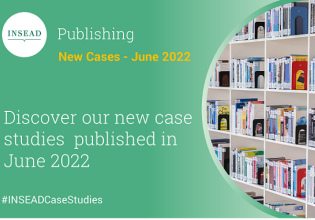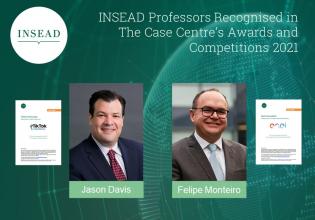01 Aug 2022
New Cases - July 2022

We are pleased to share the latest INSEAD case studies, published in July 2022!
They span multiple management challenges and opportunities encountered across a variety of industries: music, sport, fine wine, healthcare and cement production.
Professors Stephen E. Chick, Ilze Kivleniece and Ithai Stern’s new case study offers an immersive virtual reality (VR) experience to enable participants to understand healthcare as a service – notably relationships within the ‘service triangle’ between the organization, the customer, and front stage.
To learn more about The VR Immersive Learning Initiative at INSEAD, we recommend you visit https://www.insead.edu/vr-immersive-learning.
Professor Felipe Monteiro has completed a two-part case study, “FC Barcelona’s Barça Innovation Hub and Digital Innovation”. Part A traces the early development of the BIH and its plans to go global before 2020. Part B focuses on the opportunities for digital innovation that emerged from the Covid crisis. Teaching notes and a video interview with Javier Sobrino, Chief Strategy & Innovation Officer at FC Barcelona, provide further insight for registered instructors on our website.
Felipe has won four case awards in categories including “Disruptive change” and “Ethics and Social Responsibility” from The Case Centre and EFMD.
Two new cases by Professor Henrich Greve tackle two very different challenges:
- How well-defined corporate goals trigger creative efforts that help to make operations more sustainable in a heavy-polluter industry – cement production;
- How to accelerate growth of business in the niche area of fine wines, within a narrow customer segment of high-net-worth clients.
Charting the history of technological disruption, Professor Noah Askin explains the nature of competitive positioning and go-to-market strategy in a new case about Beatdapp, a digital disruptor in the music industry.
Back in June 2021, the team digital@INSEAD organised an INTHECASE webinar with the authors and protagonists of the Beatdapp case to understand how they explain their blockchain-enabled business model to customers, and the challenges of competing against established industry players.
Related reading is available from the INSEAD Knowledge article “Disruption and Anti-disruption in the Streaming Economy” by Noah Askin and Benjamin Kessler.
Read a 'scene setter’ for each of the new cases below.
Digital Music Disrupted? Beatdapp, Blockchain, and the Delicate Dance of Entering the Music Industry by Noah Askin, Laura Heely
Topic Entrepreneurship; Industry Music
On a sunny morning in December 2019, Andrew Batey and Morgan Hayduk arrived at Khimani & Associates in the Fort district of Mumbai. The founders of blockchain start-up Beatdapp had flown from Los Angeles to meet with Saregama, India’s oldest music label and largest owner of sound recordings and publishing copyrights of Indian TV and film music. They were greeted by the music lawyer Priyanka Khimani, whose clients included legendary musicians Lata Mangeshkar and Arijit Singh. Within the next hour, former Canadian Prime Minister Stephen Harper, who had joined the board of the Vancouver-based start-up two months prior, was scheduled to arrive. After months of preparation, they hoped to formalize a partnership with Saregama to use Beatdapp technology to track and authenticate media streams.
Sustainable Cement in India: What to Do when Cost-cutting Sustainability Efforts Have Become Scarce by Henrich Greve
Topic Responsibility; Region Asia
India’s cement makers have earned global recognition for their efforts to improve their energy efficiency and reduce carbon emissions. As early as 2011, a report by the World Economic Forum named Shree Cement a “new sustainability champion”. In a 2021 report, the WEF cited a pledge made by Mahendra Singi, CEO of Dalmia Cement, to follow a carbon-negative roadmap. It was made in 2018 at the Global Climate Action summit organized by California Governor Jerry Brown, with the full support of Puneet Dalmia, Managing Director of parent company Dalmia Bharat Ltd. Since then, the steps taken to reduce its carbon footprint had been largely cost effective, but as of 2020 a more ambitious approach was needed.
FC Barcelona’s Barça Innovation Hub and Digital Innovation (B): Covid Crisis as an Opportunity by Jenil Shah, L. Felipe Monteiro, Anne-Marie Carrick
Topic Strategy; Region Global; Industry Health, Wellness and Fitness, Sports
FC Barcelona (Barça) launched its in-house Barça Innovation Hub in 2017 with a mission to innovate in every segment of the sports ecosystem. The club had always striven to improve the team’s performance and build the financial resources to compete in the player transfer market, but with the creation of the BIH, pitch performance would be combined with strategic long-term initiatives – rare in the world of football. By 2020, the hub had built an end-to-end ecosystem that engaged with external partners through open innovation. Barça’s vast internal resources included more than 2,100 players and 121 teams across five professional and nine amateur sports, forming a true centre of innovation.
But in March 2020, with the Covid-19 virus causing havoc worldwide, many countries, including Spain, went into lockdown and football stadiums and merchandising outlets were closed for months. The financial impact on sport worldwide was huge, and Barça was no exception. Football and football tourism in Barcelona were put on hold.
Cru World Wine Trading and Investment Platform: A New Spin on an Old Trade by Henrich Greve, Cyndi Man Zhang, Jean Wee
Topic Strategy; Region Global; Industry Wine and Spirits
When Jeremy Howard took over a small retail wine business in 2008, he thought he could do a better job of running it than the original owners. Five years later, he had helped transform it into an online wine retailer – Cru World Wine. From there, it went on to become a highly successful platform for managing fine wines and spirits, achieving revenue of US$60 million in 2021, a five-fold increase over its first full year of operations in 2014.
Walking the Path of Expansion: MiracleFeet's Journey toward a Global Footprint by Stephen E. Chick, Ilze Kivleniece, Ithai Stern, Lisa Simone Duke, Ridhima Aggarwal
Topic Responsibility; Region Asia; Industry Hospital & Health Care
January 2021. Chesca Colloredo-Mansfeld, Co-Founder and Executive Director of MiracleFeet, and Amanda Springer, Director of Programme Operations, were discussing the challenges of their expansion strategy. For over a decade, the US-based non-profit organization had focused on the treatment of clubfoot, a congenital birth defect where one or both feet are rotated inward and downward, which limits mobility and often results in social stigma. It was correctible if properly treated. Treatment took up to four months (best initiated within the first year of life), after which a brace was worn at night for five years.
MiracleFeet helped provide access to high-quality treatment in low-income countries such as Tanzania, India and Paraguay, typically in partnership with public hospitals and managed in coordination with local NGOs. It offered low-cost braces, training, advocacy, awareness raising, and financial and operational support. Its aim was to treat over 100,000 children across the ‘addressable’ market of 70 countries (half of them middle-income countries) by 2024. With each new country entered, the target was to make affordable treatment accessible to over 70% of children with clubfoot within five years.




